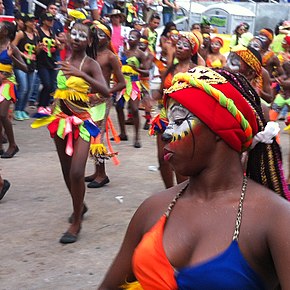Mapalé
The Mapalé is an Afro-Colombian dance rhythm. Its name comes from the teleost fish Cathorops mapale, whose movements were very fast out of the water, on the beach, compared to the agility and strength of those who dance.
Dance Style
This dance is very difficult as it takes strength and discipline to do it. This dance was born as a song and dance for the work of the fishermen in the bath, which was performed, accompanied by drums, as entertainment at night, after finishing the day. It arose on the Colombian Caribbean coast thanks to the cultural influence of the Africans trafficked as slaves during the conquest of America and who, when they managed to flee from their captors, founded quilombos or communities in remote places, such as the Palenque de San Basilio, where they affirmed their cultural heritage. Born in the Caribbean, it was introduced in ancient times along the banks of the Magdalena River. Currently it is also danced in Afro-Colombian communities in the Pacific.
In its origins, the labor dance was performed at night and accompanied by the beating of yamaró and quitambre drums, the clapping of the hands and singing. Subsequently, there was a transformation of its theme, giving it an emphasis of joy with a sexual character and assigning it the frenetic evolution that it presents today. The current choreography maintains traces of its African essence in the paraphernalia, both in the costumes, which are extremely simple, and in the presence of the machete, a work tool used to process fish. There are some widespread definitions, some of which indicate that the rhythm comes from a festival due to the abundance of fish. It is a musical genre type of the Colombian Caribbean region. This rhythm has its own African characteristics that is due to the fact that the Spanish brought African slaves to these lands, through this dance the eroticism of the union between man and woman is represented. The mapalé has strong and happy movements.
Clothing
- Man's wardrobe
He wears pants that reach the height of the heels, and a cap sometimes adorned with bangs or washers at the mouth of the leg. The costumes, both for men and women, go according to the dance and may present variations from one group to another.
- Women's wardrobe
Usually in the black dances the women wear short skirts, with fringes or small ruffles that adorn the accelerated movement of their hips. They wear flat shoes or go barefoot and wear flag turbans on their heads.
Dance
In the mapalé the couples dance loose or glued alternately. It is danced with short steps, a very fast rhythm and constant clapping of the dancers. The routines begin in two lines, one facing the other, in a confrontation between the man and the woman when they are warming up, to advance forwards and backwards. They continue with free and individual exhibition postures of the men with the purpose of pleasing their partners, who take turns reciprocating the confrontations. The dancers move rapidly and forcefully, jumping, falling, raising their arms, shaking their shoulders and hips., following the rhythm of the drums.
In the bars, there is talk of a binary rhythm, with impressive two-tone percussion, which sought to show off couples with the help of the instruments; typical Caribbean dance.
Main musical instruments of the mapalé
Alegre drum, call drum, gouache or maracas and tambora
